Methanol Synthesis by COx Hydrogenation over Cu/ZnO/Al2O3 Catalyst via Hydrotalcite-Like Precursors: the Role of CO in the Reactant Mixture
2022-03-31YingLiuXiaofangLiuLinXiaChaojieHuangZhaoxuanWuHuiWangYuhanSun
Ying Liu, Xiaofang Liu, Lin Xia, Chaojie Huang, Zhaoxuan Wu, Hui Wang,*, Yuhan Sun,3,*
1 CAS Key Laboratory of Low-Carbon Conversion Science and Engineering, Shanghai Advanced Research Institute, Chinese Academy of Sciences, Shanghai 201210, China.
2 University of Chinese Academy of Sciences, Beijing 100049, China.
3 School of Physical Science and Technology, Shanghai Tech University, Shanghai 201203, China.
Abstract:Catalytic hydrogenation of CO2 to methanol has attracted considerable attention due to its potential in alleviating global warming and mitigating the dependence on fossil fuels. Cu-based catalysts are widely used in industry because of their high activity for methanol production.However, the reaction still suffers from low methanol selectivity because of the generation of CO as a by-productvia the reverse water gas shift reaction(RWGS). The formation of another by-product H2O leads to inevitable Cu sintering, which decreases the methanol production rate. It is well known that CO can alter competitive molecular adsorption on the surface and the redox behavior of the active sites; hence, CO doping in feed gas might not only inhibit the RWGS but also minimize surface poisoning by the adsorbed oxygen. On the other hand, CO2 hydrogenation to methanol over Cu-based catalysts is a structure-sensitive reaction, and a change in the precursor can have a remarkable influence on the structure and morphology of the catalyst, and ultimately,the catalytic performance. In this work, Cu/ZnO/Al2O3 catalysts have been prepared via a hydrotalcite-like precursor (CHTCZA)and a complex phase precursor (CNP-CZA)using co-precipitation and ammonia evaporation methods. Subsequently,the performance of the two types of catalysts with different CO contents (CO2 : CO : H2 : N2 =x : (24.5 -x): 72.5 : 3)is compared at 250 °C and 5 MPa in order to explore the role of CO. The evaluation results show that both catalysts follow a similar trend in the conversion of CO and CO2 as well as the space-time-yield (STY)of MeOH and H2O. The conversions of CO2 and STYH2O decrease gradually with an increase in the CO volume, but STYMeOH is positively correlated with the CO volume. Furthermore, X-ray photoelectron spectroscopy (XPS)analysis reveals that the amount of reduced Cu species on the surface increases with increasing CO content. Judging from these results, the introduction of CO inhibits the RWGS and enhances the methanol yield for both catalysts by removing the surface oxygen as the reducing agent and thereby facilitating the exposure of the active reduced Cu species. On the other hand, transmission electron microscopy (TEM)observations indicate the doped CO may cause agglomeration of particles due to over-reduction, leading to gradual catalyst deactivation. Compared with the traditional CNP-CZA, the catalyst derived from hydrotalcite-like compounds exhibits better activity and long-term stability under all atmospheres, at different CO doping levels. This is because the hydrotalcite-like layer structure helps maintain the active metal state and confine the structure by limiting the agglomeration of Cu species.
Key Words:CO2 hydrogenation;Methanol synthesis;Cu/ZnO/Al2O3 catalyst;CO doping;Hydrotalcite-like precursors
1 Introduction
Owing to the increasing energy demand caused by industrial development and population growth, the problem of energy shortage needs to be solved urgently1. On the other hand, in the past decades, the escalating amount of CO2emission leads to many environmental problems such as global warming and sea levels rise2. CO2conversion into high value-added chemicals and fuels such as methanol has thus drawn considerable attention in the world. Methanol is not only an energy storage medium and alternative clean energy, but also an important platform chemical for producing acetic acid, dimethyl ether, formaldehyde as well as olefins (Methanol to Olefins)and gasoline (Methanol to Gasoline), which is accordingly proposed by Nobel laureate George A. Olah as “methanol economy”3-6. Therefore, the utilization of CO2as a carbon source for synthesizing methanol by catalytic hydrogenation is a promising solution to both environment and energy crisis3.
Methanol is industrially produced from synthesis gas(CO/CO2/H2)over Cu/ZnO/Al2O3catalyst under 0.1-10 MPa and 220-280 °C7,8. Although traditional Cu-based catalysts perform well overall, their gradual deactivation due to inevitable Cu sintering lowers both CO2conversion and methanol production rate. To solve the problem, a large number of researches have been conducted to improve catalyst stability and activity, and Cu/ZnO/Al2O3catalyst derived from hydrotalcitelike compounds (HTlcs)generally exhibits better performance for CO2hydrogenation to methanol than the conventionally industrial one9. The advantages of hydrotalcite-like (HTl)structure are attributed to good distribution of metallic atoms,large specific surface area and high stability against sintering10-16.Furthermore, a series of attempts have been made to improve the reaction performance of catalysts derived from HTlcs17,18. Our group has made progress in optimization of Cu/ZnO/Al2O3catalystviaHTlcs by doping metal promoter like Zr19, F20,Mn21, Y21,22in order to regulate the particle size of active metal,improve the surface area and dispersion of Cu. We also explored the optimum elemental composition ratio to maximize the exposure of Cu+and Cu0active sites9. On the other hand, it is well known that feed gas composition plays an important role in catalytic performance by modifying molecular competitive adsorption on the surface and the redox behavior of active sites.For example, a certain amount (2%-5%)of CO2in the syngas could greatly improve the methanol production rate over Cu/ZnO/Al2O35,23,24. In consideration of structural edges over Cu/ZnO/Al2O3derived from HTlcs for CO2hydrogenation, it is necessary to explore the effect of feed gas component for methanol synthesis on the Cu/ZnO/Al2O3catalystviahydrotalcite-containing precursor.
In this paper, CO2feed gas with different CO doping concentration has been employed for CO2hydrogenation over Cu/ZnO/Al2O3catalyst derived from HTlcs (CHT-CZA). In addition, the performance of the conventional industry applied Cu/ZnO/Al2O3catalystviacomplex phase precursor (CNPCZA)has also been evaluated to compare the activity and stability of both Cu/ZnO/Al2O3catalysts. Furthermore, various characterizations including powder X-ray diffraction (XRD),scanning electron microscopy (SEM), transmission electron microscope (TEM), X-ray photoelectron spectroscopy (XPS),temperature-programmed reduction of H2(H2-TPR)and desorption of CO2(CO2-TPD)were carried out to explore the reaction mechanism.
2 Experimental and computational section
2.1 Preparation of catalyst
Cu/ZnO/Al2O3derived from HTlcs were prepared with the raw material ratio of Cu2+: Zn2+: Al3+kept at 2 : 1 : 1.2 by coprecipitation at room temperature. The solution A containing Cu2+, Zn2+, Al3+nitrates (Cu(NO3)2·3H2O, AR, SCRC),(Zn(NO3)2·6H2O, AR, SCRC), (Al(NO3)3·9H2O, AR, SCRC)and solution B containing NaOH (AR, SCRC)and Na2CO3(AR,SCRC)were added simultaneously dropwise to 200 mL of deionized water under vigorous stirring. The pH value maintained at 9.5 ± 0.2 during the precipitation. Subsequently,the precipitate was stirred slowly and aged for 18 h at 65 °C, then filtered and washed with deionized water for several times to eliminate the residue sodium. The filter cakes were dried 18 h at 65 °C and noted as HT-CZA. For the purpose of comparison,another catalystviacomplex phase precursor was prepared by the ammonia-evaporation method, while ammonia (NH4OH,AR, SCRC)as a precipitant maintained the pH at 10.0 ± 0.2 throughout the precipitation. Then the precipitate was aged at 80 °C for 18 h in N2flow to remove the ammonia generated by decomposition of copper ammoniacal complex. The filter cakes were dried at the same conditions and noted as NP-CZA. Finally,both precursors were calcined in the air at 500 °C for 4 h at a heating-up rate of 2 °C·min-1and the corresponding mixed metal oxides were denoted as CHT-CZA and CNP-CZA respectively.
2.2 Characterization of catalysts
XRD patterns of as-prepared and calcined catalysts were recorded on a Rigaku Ultima 4 X-ray diffractometer using CuKαradiation source and in the 2θrange of 5°-90° with a step size of 4 (°)·min-1. The mean crystalline size (d)of Cu was determined by using Scherrer equation:
whereKis a constant 0.9,λis the wavelength of CuKαradiation,βis the half width of the peak, andθis the diffraction angle of a crystal face.
The morphology of the samples was investigated by SEM,using ZEISS Supra 55 with an accelerating voltage of 2.0 kV.To improve the conductivity, the materials were gold sputter coated prior to the analysis.
The elements compositions of samples were obtained on inductively coupled plasma-optical emission spectroscopy (ICPOES, Optima 8000, PerkinElmer).
The surface area (SBET)and pore volume (Vp)were determined by low-temperature liquid nitrogen adsorption/desorption, using a Micromeritics Tristar II 3020 instrument.
All of the catalysts (80-120 mg)were degassed at 200 °C for 12 h prior to the measurements. The Brunauer-Emmett-Teller(BET)method was used to measure the surface area by calculation from the isotherms.
TEM images were recorded with a JEOL-JEM 2011 electron microscope (200 kV)to observe the morphology of the catalysts.The samples were prepared by using ultrasonic dispersion in ethanol and then taken one droplet of suspension onto a carboncoated copper grid.
The reducibility of the calcined catalyst was measured by H2-TPR in a U-tube quartz reactor on a Micromeritics Autochem-II 2920. The temperature range was 50-800 °C. Prior to the reduction, the catalyst was pretreated with He at 200 °C for 1 h to remove physically adsorbed water and subsequently cooled down to ambient temperature. Then, the reduction was conducted under 5% H2/Ar atmosphere and the consumption of H2was collected by TCD.
CO2-TPD was also conducted on a Micromeritics Autochem-II 2920 equipped with a TCD detector to investigate the basicity of the catalysts. The catalyst (100 mg)was loaded in a U-type quartz tube and reduced under 250 °C with 5% H2/Ar flow. After holding at ambient temperature for 30 min, the sample was purged with pure CO2for 1 h. Subsequently, He passed through the sample to remove all the physically adsorbed residues. Then,the catalyst was heated up to 400 °C to start TPD experiment which used a MKS Cirrus 2 mass spectrometer to measure the desorption CO2.
The specific surface area of Cu (SCu)and dispersion (DCu)were measured by N2O chemisorption using Micromeritics AutoChem-II 2920 similar to the procedure by Gaoet al.22. Prior to the test, the catalyst (100 mg)wasin situreduced at 250 °C under 5% H2/Ar mixture for 2 h, and the consumption of H2during the process was recorded asX. The sample was then cooled down to 65 °C in He flow for 30 min and exposed to 10% N2O/N2mixture for 1 h to ensure the exposed Cu oxidized completely. After that, the sample was flushed with He to clear the residual N2O and cooled down to ambient temperature.Finally, the oxidized catalyst was purged in 5% H2/Ar at 300 °C to reduce the surface Cu+, and the consumption of H2was recorded asY. The dispersion of Cu (DCu)and exposed Cu surface area (SCu)were calculated using Eqs. (2)and (3):

whereDCuwas the dispersion of Cu,SCuwas the exposed copper surface area per gram catalyst,Nwas Avogadro’s constant (6.02 ×1023atoms·mol-1), and 1.4 × 1019was the number of copper atoms per square meter25,26.
XPS measurements were acquired using a Thermo Scientific K-Alpha spectrometer equipped with AlKαradiation (150 W,hv= 1486.6 eV)to analyze the surface compositions of the catalysts. All calibrated measures of binding energies were adjusted by the carbon deposit C 1s(Eb= 284.8 eV).
2.3 Evaluation of catalysts
Methanol synthesis experiments were tested using a continuous flow fixed-bed reactor consisting of a stainless steel tube. For each experiment, 1.5 mL of the fresh catalyst was diluted with the equivalent-volume quartz sand (both in 40-60 mesh)packing in the reactor. Before reaction, the catalyst was reduced in pure H2under the conditions of 3200 h-1gas hourly space velocity (GHSV)and 1 MPa by increasing the temperature to 250 °C and holding for 5 h. For the purpose of comparison,all of the reaction tests were carried out under the same reaction conditions: 250 °C, 5.0 MPa, GHSV = 4000 h-1. The steady state activity measurements were taken every 24 h on the stream. To study the relationship between catalytic activity and CO content,a series of test results were obtained by adjusting the composition of feed gas (CO2: CO : H2: N2=x: (24.5 -x):72.5 : 3)as listed in Table S1 (in Supporting Information).Effluent products such as H2, N2, CO, CH4and CO2were quantitatively analyzed by Shimadzu GC-2010C gas chromatography (GC)equipped with a thermal conductivity detector (TCD, TDX-01 column)and the liquid products CH3OH and H2O were analyzed by another Shimadzu GC-2010C GC equipped with TCD (Porapak-Q column).
The conversions of CO2and CO were defined as:

where (in)stood for CO2and CO concentration at the inlet, (out)represented the CO2and CO concentration at the outlet.
The yield of CH3OH (STYCH3OH)represented the amounts of CH3OH produced per volume catalyst per hour, which was defined as Eq. (6):

W,XCH3OH,tandvindicated the total weight of the liquid products (g), the mass fraction of CH3OH, the reaction time (h)and the volume of catalyst (mL), respectively.
3 Results and discussion
3.1 Textural and structural properties of catalysts
XRD patterns of the precursor, calcined and reduced Cu/ZnO/Al2O3samples were presented in Fig. 1. As shown in Fig. 1a, several major peaks could be observed for the typical HTl structure on HT-CZA, such as the symmetrical peaks at 2θvalue of 12°, 24°, 60°, 61° belonging to (003), (006), (110)and(113)plane, broad peaks at 34°, 39° and 47° attributed to (009),(115)and (118)plane, respectively27-29. In comparison,[Zn3Al94O144] (JCPDS 23-1490), [Zn6Al2O9] (JCPDS 51-0037)complex oxides and Cu/Zn-malachite phase[(Cu,Zn)2(OH)2CO3] (JCPDS 36-1475)were detected on NPCZA. After calcination, the HTl structure was completely destroyed10,30and considerably broadened diffraction peaks emerged at 2θ= 35°-37° as in Fig. 1b. It is worth mentioning that the intensity of metallic Cu peaks of reduced CHT-CZA was much weaker than that of reduced CNP-CZA, which indicated a well-dispersion of metallic Cu on the former one. Combining with the property that particle size of metallic Cu on reduced CNP-CZA was larger than that of reduced CHT-CZA (Table 1),which acted as active component for methanol synthesis, a tentative conclusion could be drawn that the layer structure of HTl precursor effectively inhibited Cu aggregation by promoting dispersion of Cu2+on the surface of the layered structure31.

Fig. 1 XRD patterns of the two types of Cu/ZnO/Al2O3 samples at different stages.

Table 1 Chemical composition of the prepared samples.
3.2 Physical properties of Cu/ZnO/Al2O3 catalysts
The physicochemical properties of CHT-CZA and CNP-CZA catalysts were summarized in Tables 1 and 2. The actual metal content of the catalysts measured by ICP-OES was nearly the same as the theoretical calculation. Although the BET surface area of CHT-CZA catalyst was less than CNP-CZA, the largerCu dispersion and exposed Cu surface area of the former was determined by N2O chemisorption, indicating more active Cu sites located in the layered structure of Cu/ZnO/Al2O3with hydrotalcite-like precursors, which would create more catalytically active species and promote the catalytic performance more efficiently.

Table 2 Physicochemical properties of Cu/ZnO/Al2O3 catalysts.
SEM images could give detailed information about the morphology and microstructures of the individual particles. Fig.2a1-a2 showed that the HT-CZA precursor consisted of highly dispersed platelet-like structure approximately 100-200 nm in size. In addition, the platelets were well grown and intercrossed with each other. By contrast, the NP-CZA precursor exhibited a block-like morphology of a much larger particle size nearly 5 μm. Images of calcined and reduced samples were illustrated in Fig. 2b,2c and the microstructures were confirmed to be identical with the precursors. It’s worth mentioning that comparing calcined/reduced samples of CHT-CZA with CNP-CZA counterparts, the former displayed finely-distributed denser layers.

Fig. 2 SEM images of two types of CZA samples.
3.3 Reducibility of Cu/ZnO/Al2O3 catalysts
TPR measurement was carried out to investigate the reduction activity for the two types of calcined Cu/ZnO/Al2O3samples as in Fig. 3. The reduction profiles of CHT-CZA sample showed a dominant reduction peak at 256.3 °C accompanied with a small shoulder at 192.9 °C. While for CNP-CZA catalyst, a broad reduction peak at 209.6 °C emerged with an inconspicuous shoulder toward higher temperature at 232.5 °C. To get more insight into the TPR results, we divided the profile into several Gaussian peaks. According to the H2consumption temperature,it could be divided into two types of CuO species: the lower temperature peak (peak β)assigned to reduction of surface dispersed CuO, and the higher one (peak γ)attributed to that of the bulk CuO32,33. And another peak at lower temperature (peak α)on the CHT-CZA samples could be assigned to the reduction of highly dispersed CuO19,22. Furthermore, we observed that the reduction temperature for the CHT-CZA catalyst was higher than that of CNP-CZA. The shift in reduction temperature was attributed to the Cu2+, which had to separate from the Zn-Aloxide matrix and coalesce into clusters to finally form metallic Cu34. In other words, a stronger interfacial interaction might exist between Cu and ZnO on CHT-CZA catalyst.
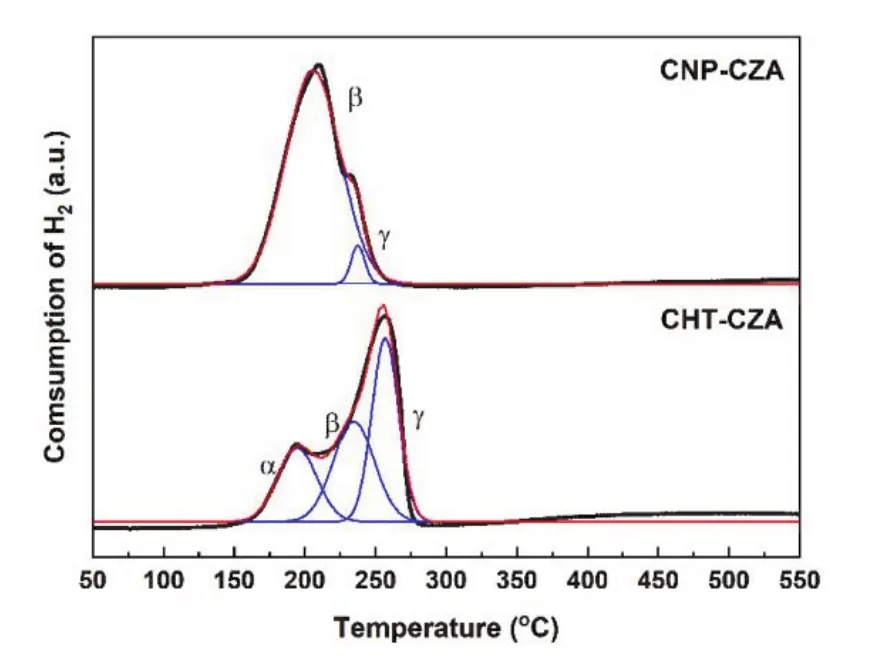
Fig. 3 H2-TPR profiles of the two types of Cu/ZnO/Al2O3 samples.
3.4 The surface basicity of calcined samples
CO2-TPD profiles in Fig. 4 can be divided into three regions:85-95 °C, 167-177 °C, 367-377 °C, corresponding to α, β and γ peaks, respectively35,36. The α peak represented the weak basic sites assigned to the OH-group, β peak suggested the medium basic sites bonded to metal-oxygen ion pair and γ peak stood for the strong alkaline sites related to the coordination unsaturated O2-ions. Notably, the γ peak on CHT-CZA shifted to higher temperature than that on CNP-CZA, which indicated more strong basic sites were exposed on the surface of lamellar structure. Besides, it is obvious that the peak area of moderately and strongly basic sites on CHT-CZA are larger than that of CNP-CZA, which could be attributed to the special structure of HTlcs consisting of positively charged HTl layers and negatively charged interlayer anions. Larger amounts of Cu2+and Al3+cation located in the layers, leading to ready formation of coordinatively unsaturated O2-19.
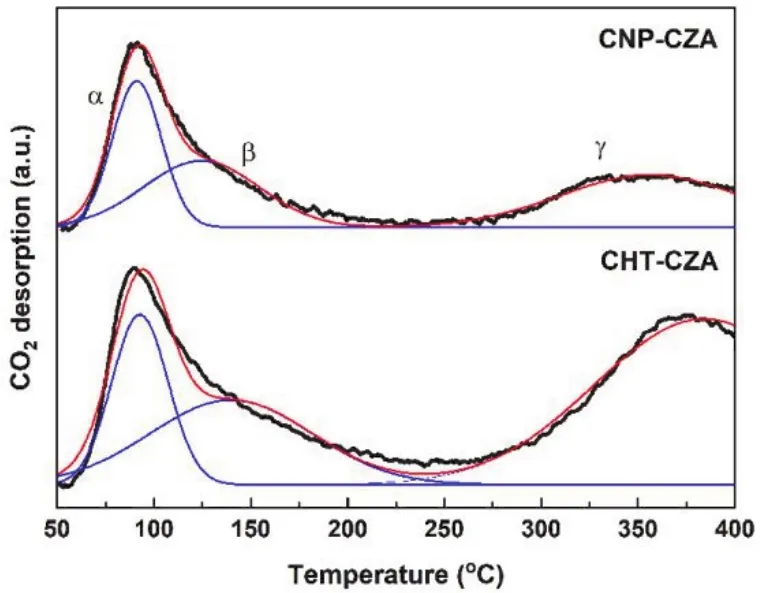
Fig. 4 CO2-TPD profiles of the Cu/ZnO/Al2O3 samples.
3.5 Effect of CO in the reactant mixture
Fig. 5 presented the evaluation results for methanol synthesis under condition of 5 MPa and 250 °C. It was obvious that CHTCZA catalyst gained advantages over CNP-CZA one at any feed gas conditions in terms of CO2conversion and methanol production rate, which may be attributed to its strong base sites(CO2-TPD,vide supra)beneficial for CO2chemisorption and higher dispersed Cu (dissociative N2O adsorption,vide supra)in the platelet-like structure for methanol production21.
However, it has been reported that the high concentration of H2O by-produced during methanol synthesis would suppress the activity of the Cu catalyst sites by partial oxidation23,37,38. Amid the H2O/H2redox process, the produced oxygen species deposited onto the surface of the Cu, which would diminish the number of active sites for CO2hydrogenation to methanol23,39.If introducing CO into the feed gas, CO could act as reducing agent to remove the surface oxygen and promote the exposure of more active sites, thus maintaining the activity and stability of Cu-based catalysts for CO2hydrogenation to methanol.
Fig. 5a-d showed the evaluation results with various CO contents in feed gas. Obviously, both catalysts followed the similar trend in conversion of CO and CO2as well as STY(space-time-yield)of CH3OH and H2O under different CO doping amount. Furthermore, CO conversion and STYCH3OHwas positively correlated with CO volume fraction, while CO2conversion and STYH2Oinversely related to CO volume fraction.
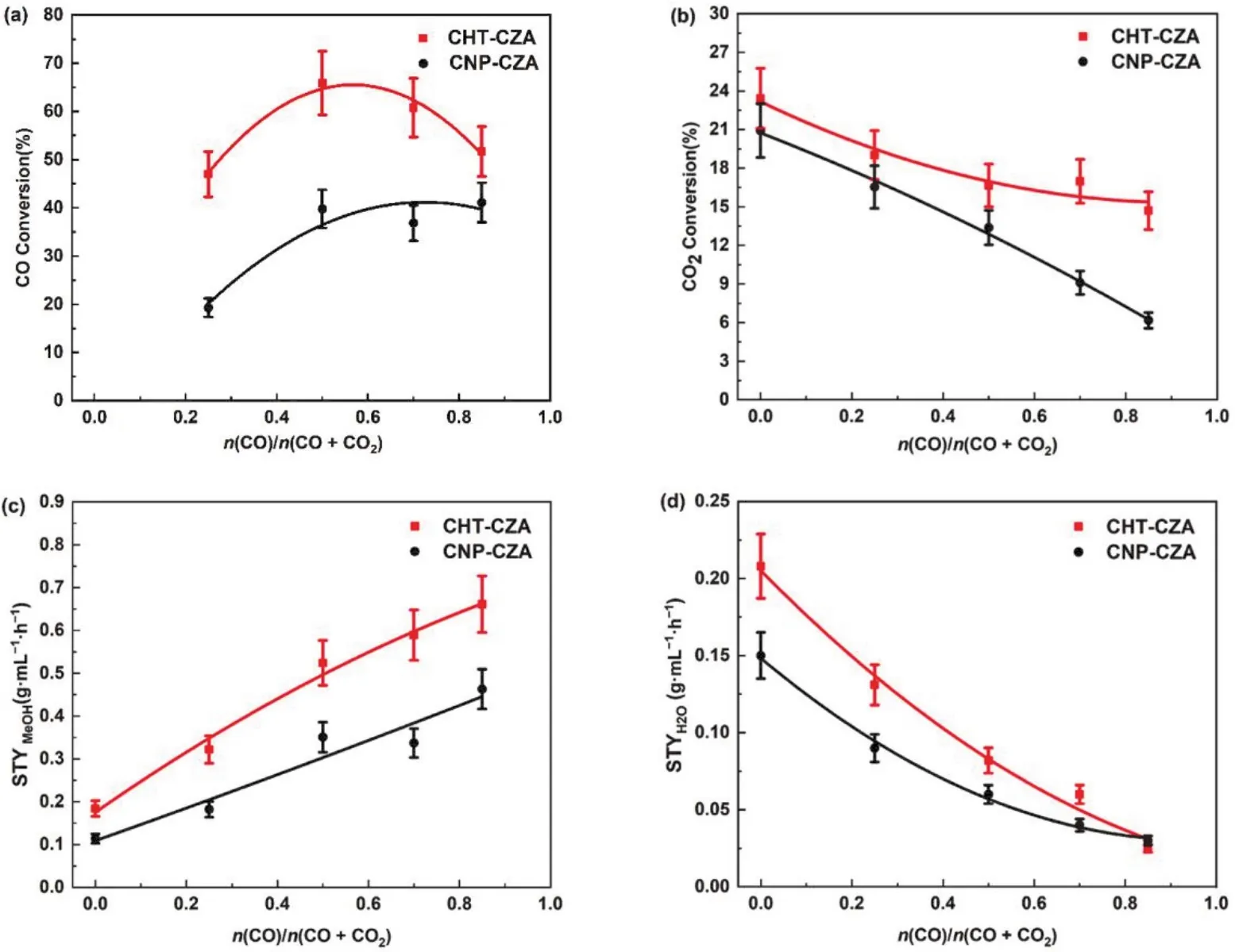
Fig. 5 Comparison of CZA catalysts with different CO content in feed gas for CO2 hydrogenation to methanol: conversion of CO (a)and CO2 (b); STY of methanol (c)and H2O (d).
As speculated, the introduction of CO led to a significant decrease in CO2conversion, which was because CO shifted the equilibrium of reaction (3)towards the right side (producing CO2). The process was generally believed to scavenge surface oxygen and achieve exposure of more active Cu sites40-42.Therefore, more active Cu enhanced the tendency of CO2to methanol, which led to an improvement in methanol production rate. With the shrinkage of CO2content, the production rate of H2O (by-produced through CO2hydrogenation to methanol,reaction (7))dropped evidently, which further lowered the consumption of CO due to the decline in surface oxidation rate.
It was worth mentioning that a wider performance gap emerged in CO2conversion and methanol production rate between both catalysts with CO doping ascending. In other words, CO2conversion dropped faster but methanol production rate rose slower on CNP-CZA than those on CHT-CZA, which would be revealed by further surface analysis. Fig. 6a illustrated the typical XPS spectrum of Cu 2p3/2core levels of the samples after reaction in different CO doping amount, that is, pure CO2,50% and 85% CO volume proportion. The XPS principal peak of binding energy approximately at 936.5 eV was assigned to Cu2+species, while the peak at 934.0 eV was attributed to reduced Cu+/Cu0species. Table 3 tabulated the binding energy and surface composition of the catalysts after reaction with different feed gas. The content of Cu2+on CNP-CZA declined from 74.70% to 70.80% and further to 68.72% when the CO content rose from 0 to 50% and 85%, respectively, which was ascribed to gradual reduction of surface Cu2+species by CO.Compared with CNP-CZA catalyst, no significant changes of Cu2+/(Cu++ Cu0)occurred on CHT-CZA under diverse CO volume proportion. In a word, raising CO content brought about more reduced Cu+and Cu0on CNP-CZA than that on CHTCZA. These results implied the intensity of over-reduction occurring on the surface of CHT-CZA was less than that on CNP-CZA, which might be attributed to stronger interfacial interaction of the former as confirmed by TPR.

Table 3 Binding energies (eV)of core electrons of Cu 2p3/2 and surface composition in Cu/ZnO/Al2O3 catalyst at different reaction atmospheres.
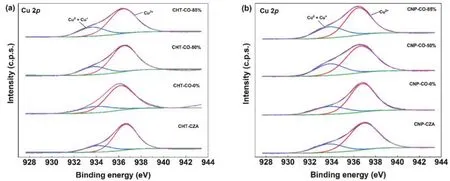
Fig. 6 The Cu 2p3/2 core-level spectra of spent catalysts in different feed gas: (a)CHT-CZA; (b)CNP-CZA.
Furthermore, the discrepant effect of different CO content on two catalysts would be clarified using TEM and HRTEM characterizations to explore the morphological and structural variation of both catalysts. Firstly, as shown in Fig. 7a1-a2, the surface of reduced CHT-CZA was decorated with small metallic Cu embedded in a metal oxide matrix, which resulted in closer interfacial contact between metallic Cu particles and continuous oxide phase22. Fig. 7c1-c3 exhibited the TEM images of the spent CHT-CZA catalysts after reaction with 0%, 50% and 85% CO contents, and a uniform dispersion of CuO and ZnO species on the lamellar plates could be clearly observed. When CO proportion reached 85%, a small amount of metallic Cu appeared on the surface due to the high concentration of CO rendering part of metallic Cu separate out from Zn-Al-oxide matrix, which was difficult to be oxidized. In comparison, highly crystalline Cu with large particle size and individually separated ZnO particles could be found on reduced CNP-CZA (Fig. 7b2). As the CO content in feed gas rose, Cu and ZnO species separated evidently and formed well crystallized particles on spent CNP-CZA.
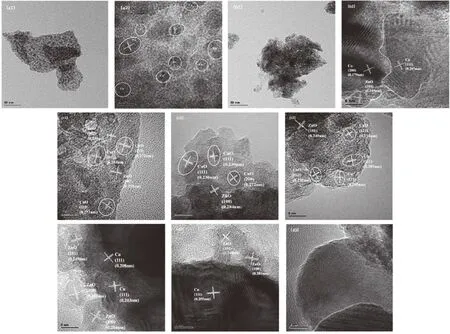
Fig. 7 TEM images of Cu/ZnO/Al2O3 samples after different treatments: reduced catalysts (a1)CHT-CZA, (b1)CNP-CZA; and HRTEM images: reduced catalysts (a2)CHT-CZA, (b2)CNP-CZA; and spent catalysts (c1)CHT-CO-0%, (c2)CHT-CO-50%,(c3)CHT-CO-85%; (d1)CNP-CO-0%, (d2)CHT-CO-50%, (d3)CNP-CO-85%.
According to the XPS and TEM results, Cu+and Cu0are proposed to act as active sites for the CO2hydrogenation to methanol. It has indicated that activity for methanol synthesis correlated with copper metal area38,43. High concentration of CO accelerated reduction of surface metal37and promoted exposure of more Cu+and Cu0sites, improving the methanol production rate. On the other hand, the particles agglomeration led to a significant loss of Cu surface area23,24,44,which decreased the total number of active sites continuously. However, under the same reaction conditions the interaction between Cu and ZnO in reduced CHT-CZA was stronger than that in reduced CNP-CZA,which led to more exposure of Cu surface area by inhibiting the separation of the metal active phase. The interaction could be attributed to better structure-confined effect originating from the special hydrotalcite-layered structure of HT-CZA.
Based on the characterizations results obtained so far, we drawn the conclusion that the catalyst derived from HTl precursor could withstand over-reduction by CO and refrain Cu particles from enlargement and agglomeration, therefore maintaining more active Cu sites for efficient CO2hydrogenation to methanol.
3.6 Catalyst stability
To investigate and compare the stability of CHT-CZA and CNP-CZA catalyst under different CO doping atmospheres, we conducted the long-term performance test of 216 h in the fix-bed reactor shown in Fig. 8. Initially, both catalysts maintained good stability with time-on-stream in the absence of CO. The methanol production rate over CHT-CZA catalyst kept at 0.176 g·mL-1·h-1)during the test, which was 1.57 times higher than that of CNP-CZA. With CO content escalated, it was clear that CNP-CZA catalyst suffered from significant deactivation, which was due to over-reduction of Cu by CO and resultant separation of active phase24. When CO accounted for 50%, the deactivation rate reached roughly 0.15%·h-1. With CO proportion exceeding 85% in feed gas, deactivation on CNP-CZA occurred at a rate of 0.16%·h-1, which was more than twice that on CHT-CZA(0.07%·h-1). In a word, CHT-CZA one exhibited better durability, which could be owed to its special hydrotalcitelayered structure restraining CuO from sintering.

Fig. 8 Effect of different CO volume doping into CO2 on the stability for methanol synthesis.
4 Conclusions
CO2feed gas with various CO-doping contents was employed for CO2hydrogenation to methanol over Cu/ZnO/Al2O3catalysts derived from hydrotalcite-like precursor and traditionally complex phase precursor. The results revealed that the strong reducibility of CO could promote more exposure of reduced Cu species which acted as the active sites for CO2hydrogenation. On the other hand, the doped CO could enlarge the particle size and agglomerate metallic Cu, leading to gradual catalyst deactivation. By comparison, the hydrotalcite-structured catalyst exhibited better activity and long-term stability than traditionally industrial one at any atmosphere. This could be attributed to its unique layer structure, which not only improved the metal dispersion, but also restricted Cu particles from agglomeration deactivation. In addition, compared to CNP-CZA catalyst, CHT-CZA exhibit more superiority of catalytic performance in CO hydrogenation, especially for the improvement of catalytic stability.
Supporting Information:available free of chargeviathe internet at http://www.whxb.pku.edu.cn.
